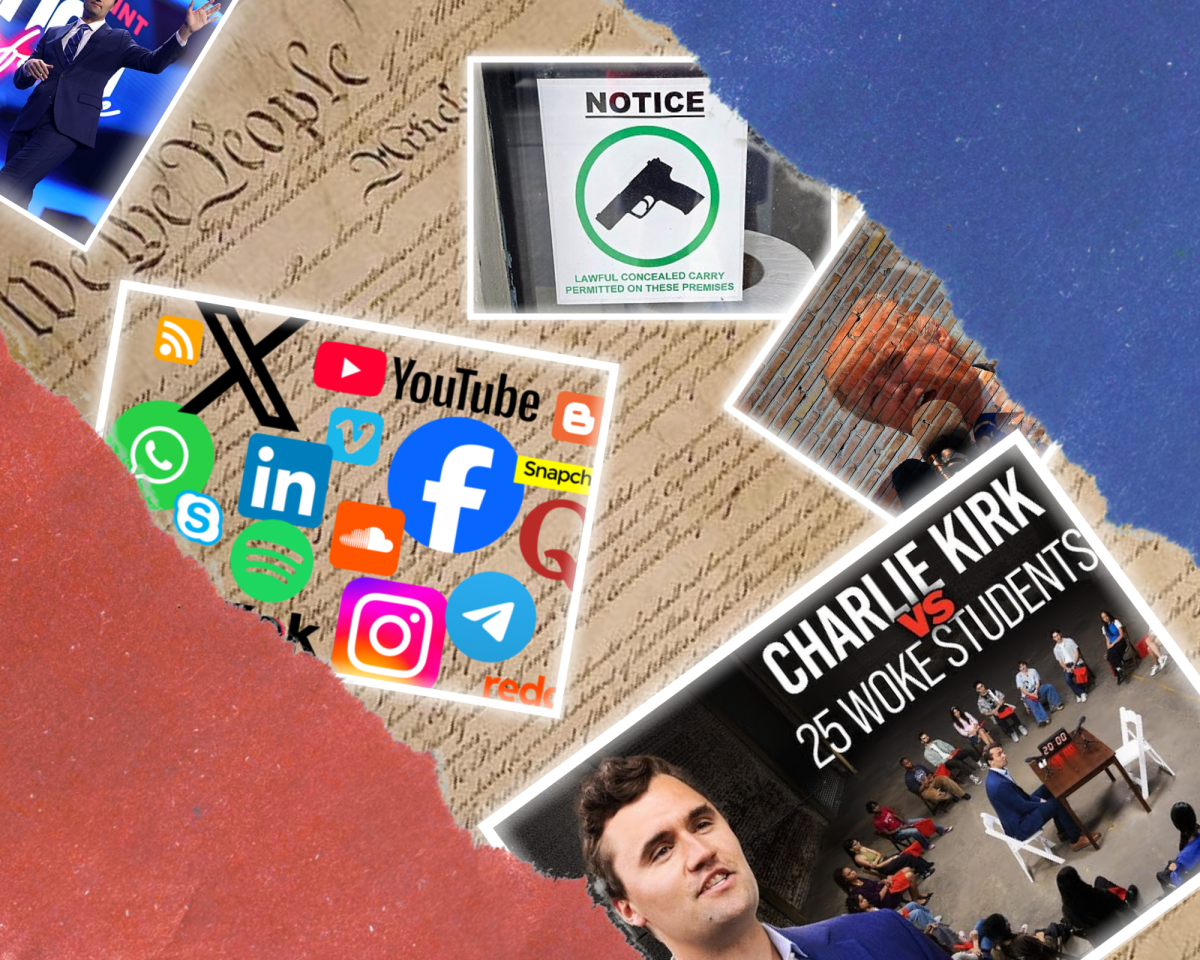The first time I saw Charlie Kirk, he was debating a college student in a video posted by Jubilee — a YouTube channel known for hosting debates and social experiments between people of opposing viewpoints. He was wearing that smile — the one people call creepy — and made a comment along the lines of, “A fetus means ‘little human being’ in Latin.” Although I’m not a conservative Christian, and do not align with an overwhelming majority of Kirk’s viewpoints, I was still drawn into the clip. As I watched more of his recorded speeches at events, I felt a constant tension between disgust and fascination. Over time, Kirk was impossible to avoid. He was a constant ragebait in the background of my feed, resurfacing every few days with another viral, incendiary remark.
So when Kirk was assassinated while speaking at Utah Valley University, I was horrified by the violence but also by how quickly the shooting was turned into content. The video of him being shot in the neck spread online within minutes, replayed and saved like any other viral clip. It was unsettling to see people’s lack of empathy for a human getting killed, just because they disagreed with him politically.
Eventually, the conversation around Kirk’s death became less about the loss of life through gun violence, and more about which “side” was to blame — proof of how political polarization has displaced our shared sense of humanity as a societal value.
The Audience Kirk Built
Kirk didn’t coincidentally enthrall Gen Z; he built a brand carefully curated for algorithmic boosts, whether through conservative support or liberal outrage. Specifically, Kirk produced viral debate clips where he would assert provocative statements, from claims about gender and race to denunciations of gun control. His events on college campuses — especially his “Prove Me Wrong” tours — were extensions of his social media presence, essentially live versions of the same high-tension interactions.
Similarly, when Jubilee publishes videos like “1 Conservative vs 25 Liberal College Students (Feat. Charlie Kirk)” or “1 Liberal Teen vs 20 Trump Supporters,” the debate is set up for conflict before anyone even speaks.
These “conversations” aren’t built for a potential understanding of the other side. Not only are people with polarized views debating without truly listening to one another, viewers also subconsciously default to the side closest to their own ideologies, walking away more entrenched in their beliefs. Online audiences, in turn, clip and post the most outrageous or affirming moments — often out of context and not fact-checked.
Kirk knew exactly how to feed into this effect through appalling statements such as:
- “If I see a Black pilot, I’m going to be like, ‘Boy, I hope he’s qualified.’”
- “We need to have a Nuremberg-style trial for every gender-affirming clinic doctor.”
- “I think it’s worth it to have a cost of, unfortunately, some gun deaths every single year so that we can have the Second Amendment to protect our other God-given rights.”
The algorithm rewarded him for that. We, as a generation, are constantly consuming and spreading media, calling attention to things that anger us just as easily as we do with things we agree with. That’s how Kirk became a part of my social media feed, even though I didn’t share his perspective on the world. He didn’t need people to agree with him; he just needed to convince people to keep watching. Every video reaction — even the hate-watches — only increased his visibility, and maximized support among those already inclined to his beliefs.
All this attention gets transformed into merchandise, donor dollars, echo chambers of critique and counter-critique — and most importantly, a network of young conservatives unified by resentment toward what they perceive as an increasingly liberal social order.
Kirk as a Martyr
Kirk’s death led to a range of misguided reactions across the political spectrum. On one hand, some people who preached gun control celebrated the gun violence that led to his death. You can’t condemn school shootings and then applaud a political one. On the other hand, some mourned his death and became vengeful; almost instantly — and disturbingly so — Kirk became a martyr for many.
Martyrdom has always been a powerful political tool, from early Christian saints who galvanized faith through persecution to modern nationalist movements that enshrine “fallen heroes” as symbols of purity and resistance. The idea behind it is simple but effective: portray someone as being killed for their beliefs, claim moral persecution, mobilize the faithful and expand power. It worked then, and it works now.
In the weeks after Kirk’s death, the impulse toward political spectacle became inevitable. Lawmakers in Oklahoma and Texas introduced bills to mandate statues of Kirk on public campuses. His memorial service in Glendale, Ariz., attracted tens of thousands of supporters who called his life and death a “turning point” in a civilizational conflict. U.S. Homeland Security Advisor Stephen Miller even vowed to defeat an unspecified “you” he held responsible — this “you” can easily accommodate anyone who opposes their movement.
Instead of reckoning with the conditions that led to this incident, the right wing reframed this as a rally cry. Midway through his eulogies, Trump described Kirk as a “martyr for truth and freedom,” using Kirk’s death as a means for political mobilization. Right-wing media followed suit in a declaration that a new “war” had begun, urging retribution against the left before the killer was even named.
In doing so, Kirk’s death was repurposed into a call to arms, and towards even more severe polarization. This motive shifts the focus from the central political issue at hand — how a culture of political hostility and easy access to guns made such a killing possible — and uses the isolated actions of one shooter to reduce a complex ideology into a single enemy. Rather than prompting reflection on the status quo, the event was used to further diminish willingness to engage with opposing viewpoints. Our social media-driven public discourse reverted to the same platforms that elevated Kirk — only now, it’s accelerated by his absence.
By turning Kirk’s death into a partisan rallying point, we’ve lost yet another chance to confront what truly enables such violence. The real issue here — besides political division itself — is a media system that profits off that political division. When every tragedy becomes an opportunity to reinforce one side’s moral superiority, we stop asking the more difficult, but necessary, questions: How do we reduce violence while protecting First Amendment rights? How can we take accountability for our divided political landscape? At what point do we value defending our narrow worldviews more than real human lives?
Closing Thoughts
I never aligned with Kirk’s political views, and it’s unsettling to see his reach with people my age. But reactions to his death say much more about us than about him. Instead of his killing being just another viral moment or ideological weapon, it should be a wake-up call to discuss the heart of the issue: a reassessment of gun violence, and how we process political conflict through social media.
I hope this moment reminds us that outrage cannot be our only form of civic engagement. We need systems that protect speech and safety — that don’t wait for more death to provide proof for this idea. Because if the only stories that resonate are tragedies, it’s an indication that we have fallen into a cycle we must break.




